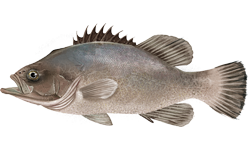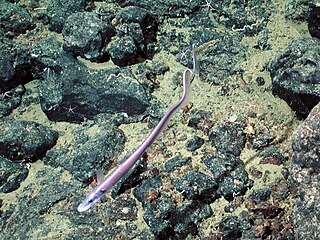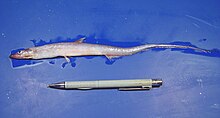
Sweepers are small, tropical marine perciform fish of the family Pempheridae. Found in the western Atlantic Ocean and Indo-Pacific region, the family contains about 26 species in two genera. One species is the target of subsistence fisheries in Japan, where the fish is much enjoyed for its taste. Sweepers are occasionally kept in marine aquaria.
Pearlfish are marine fish in the ray-finned fish family Carapidae. Pearlfishes inhabit the tropical waters of the Atlantic, Indian, and Pacific Oceans at depths to 2,000 m (6,600 ft), along oceanic shelves and slopes. They are slender, elongated fish with no scales, translucent bodies, and dorsal fin rays which are shorter than their anal fin rays. Adults of most species live symbiotically inside various invertebrate hosts, and some live parasitically inside sea cucumbers. The larvae are free living.

The ladyfish or tenpounder is a species of fish in the genus Elops, the only genus in the monotypic family Elopidae.

The wreckfish are a family, Polyprionidae in the suborder Percoidei of the order Perciformes.

The mojarras are a family, Gerreidae, of fish in the order Perciformes. The family includes about 53 species found worldwide in tropical and warm temperate regions. They mostly inhabit coastal salt and brackish waters, although some occur in fresh water.

Fundulidae is the family of topminnows and North American killifishes.

The West African ladyfish is a species of fish in the family Elopidae. It is native to the coastal waters of the eastern Atlantic Ocean, from Senegal to Angola. It is also known as the Guinean ladyfish. Some have been known to grow to 20 lb.
Pterothrissus gissu, also known as the Japanese gissu, is a species of fish in the family Albulidae. The Japanese gissu is a rare fish that is distributed in deep water off northwest Pacific Ocean. This fish is known to pass through a leptocephalus larval stage, but only metamorphosed specimens have been available. This species is the only member of its genus.
The Greek lamprey is a species of jawless fish in the Petromyzontidae family. It is endemic to Greece. Its natural habitats are rivers and freshwater springs. It is threatened by habitat loss. This species may be better included in the genus Caspiomyzon. It is the most endangered species of lamprey. It lives only in the Strymon and Louros river basins.

The Syr Darya sturgeon is a species of fish in the family Acipenseridae. It is found in Kazakhstan, Tajikistan and Uzbekistan, where it is endemic to the Syr Darya River and, before its drainage, the Aral Sea. Due to the loss of its breeding site and damming projects over the length of the river, it is currently considered Critically Endangered and likely extinct, as no sightings have been reported since 1960. The sturgeon is among the 25 “most wanted lost” species that are the focus of Global Wildlife Conservation's “Search for Lost Species” initiative.

The oceanic basslets are ray-finned fish that belong to the small family Howellidae within the superfamily Percoidea of the [[suborder Percoidei part of the order Perciformes. The family includes about 9 species. They are mostly deep-water species, some of which move to shallower waters at night. Various species are found in the Indian Ocean, Pacific Ocean, including the Coral Sea, and Atlantic Ocean, including the Caribbean Sea.

Aldrovandia is a genus of fish in the family Halosauridae. This genus currently contains the following recognized species:
Aldrovandia phalacra, the Hawaiian halosaurid, is a species of ray-finned fish in the family Halosauridae. It is a circumglobal species found at bathyal depths.

Fodiator is a genus of flying fishes. It is the only genus in the subfamily Fodiatorinae.
Halosaurus johnsonianus, also called the Sahara halosaur, is a deep-sea fish in the family Halosauridae. It is found in the eastern Atlantic Ocean from southern Spain and Portugal to Mauritania, including the Azores and Canary Islands. It is a benthopelagic species living on the continental slope in depths from 800 to 2,200 m. It grows to 50 cm (20 in) total length.

The sixgill hagfish or snotslang is a species of marine fish in the hagfish family of order Myxiniformes. It is native to the South Atlantic Ocean and southwestern Indian Ocean.
Porichthyinae is a subfamily of toadfish in the family Batrachoididae. They are found in the eastern Pacific Ocean and western Atlantic from Canada to Argentina. The species of this subfamily have no venom glands or subopercular spines, they have canine like teeth and two solid spines in the dorsal fin.
Nemoossis belloci, also known as the long-fin bonefish is a species of fish in the family Albulidae endemic to the eastern Atlantic Ocean. This species is the only member of its genus.

Ophidiinae is a subfamily of the cusk eel family Ophidiidae. The species in the subfamily are characterised by having their pelvic fins situated far forward on the body and supported by an forward orientated extension of the pelvic girdle, they lack barbels on the mouth and chin and they are covered in small cycloid scales arranged in horizontal or diagonal rows. Some species have a modified swim bladder and the anterior vertebrae which enables them to generate sounds. and some of these modifications are sexually dimorphic and make the fish capable of generating sound. They have two rays in each ventral fin and the caudal fin has 9 rays. Most species are benthic and occur on the continental shelf.

Oxudercidae is a family of gobies which consists of four subfamilies which were formerly classified under the family Gobiidae. The family is sometimes called the Gobionellidae, but Oxudercidae has priority. The species in this family have a cosmopolitan distribution in temperate and tropical areas and are found in marine and freshwater environments, typically in inshore, euryhaline areas with silt and sand substrates.













